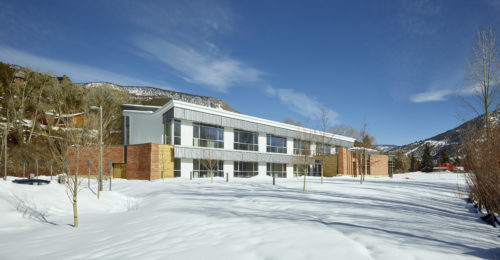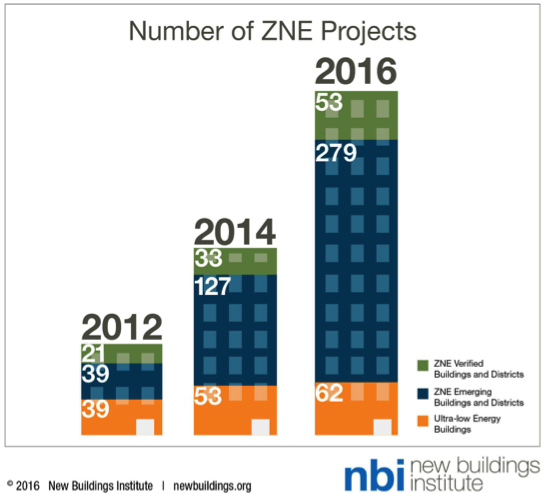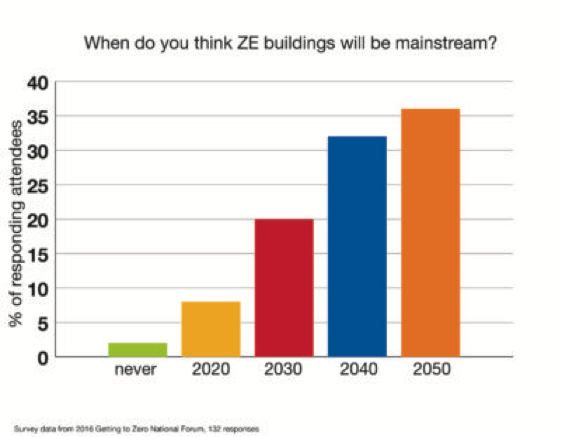
Net-Zero Energy Buildings: Three career paths for students to revolutionize the built environment and decarbonize the energy sector
The net-zero energy (NZE) movement is gaining momentum, revolutionizing building design and construction and presenting new career opportunities for students. As a student myself with a strong interest in sustainable design and building science, I have been closely following the industry’s momentum. Trends that have arisen in the NZE movement are helping me to determine where I can best focus my efforts toward a career path that holds strong potential for my personal and professional ambitions. With hopes of expanding my knowledge of NZE buildings, while also working alongside professionals in the industry, I was drawn to Rocky Mountain Institute (RMI) for an internship during January. Over the past month, I have been fascinated by the wide variety of technologies, systems, and industries that are integral to the success of an NZE building, such as the RMI Innovation Center. This experience also opened my eyes to the expansive opportunities to get involved in this growing movement, which is redefining buildings as we know them.

The Future of NZE Buildings
In order to strategically and aggressively promote NZE buildings, various organizations and states have set targets to achieve widespread implementation of NZE buildings, as well as entire districts and communities. Here at Rocky Mountain Institute, we aim to transform the buildings market and implement low-energy and zero-energy solutions to save 50 million tons of carbon over the next five years. Additionally, the Architecture 2030 challenge calls for all new developments, major renovations, and new buildings to be carbon neutral by 2030 through the use of on-site renewable energy, sustainable design, and/or the purchase of a maximum of 20 percent renewable energy. In addition to targets set by national organizations, the State of California has established goals to have all new residential construction NZE by 2020, and all new commercial construction NZE by 2030. These guidelines and targets will help to propel the NZE movement and decarbonize the buildings sector.
At the 2016 Getting to Zero National Forum, hosted by the New Buildings Institute and Rocky Mountain Institute, a majority of industry professionals indicated that they believe NZE will mainstream between 2040 and 2050. Over the next 20 to 30 years, the success of NZE buildings will depend on implementation and promotion by a variety of industries and sectors. Key stakeholders, including building owners, architects, contractors, engineers, and designers, to name a few, must work collaboratively to creatively design energy-efficient residential and commercial buildings that are powered by renewable energy.

For students, this is an exciting time to enter a movement that is rapidly transforming the buildings in our towns, cities, and states. Over the the next few decades, a variety of industries will call on young individuals to rethink traditional building design and construction methods and processes. Students can make a change in the sector that meets their own interests and expertise—whether architecture, engineering, or even public policy—while building a better future for the planet and people on it.
Three Career Paths for Students Interested in NZE
- Architecture: Architects are foundational to every home, commercial building, school, and shopping center that has ever been built. In charge of designing each square foot of a new construction project, architects are poised to be one of the most integral components of revolutionizing NZE buildings. One way to improve energy efficiency through design is the use of passive energy strategies, achieved through building layout. RMI’s NZE Innovation Center, located in Basalt, Colorado, is the highest performing building in the coldest climate zone in the United States when it comes to energy. One way that NZE was achieved was through building orientation and passive performance. The south-facing wall of the Innovation Center is made up of 52 percent windows, whereas the north is only 18 percent windows. This allows for optimized daylighting, which reduces indoor lighting demands while also improving passive solar heat gain. This is one of the many ways that building design can lead to improved energy efficiency. In 2014, 1.3 million architects from 124 countries represented by member organizations of the International Union of Architects signed a document, named the 2050 Imperative, committing to 100 percent NZE design and construction by 2050. These industry leaders recognize their integral role in reducing carbon emissions and redesigning buildings for the future. If you are a student drawn to design, join the millions of architecture professionals who are already making efforts to transform the buildings sector.
- Engineering: Students interested in pursuing civil, mechanical, material, environmental, or software engineering also have an essential role in the NZE movement. Not only are NZE residential and commercial buildings helping to decarbonize the built environment, they are also revolutionizing the technologies, strategies, and materials used in building design and construction. One of the strategies to increase energy efficiency in buildings is through system automation and integration. Many NZE homes and offices utilize passive techniques such as solar heat gain. They also have a variety of automated systems that are synchronized to incorporate information such as temperature, humidity, weather forecasts, and number of occupants. This information dictates how a building’s heating and cooling systems satisfy occupant comfort while minimizing energy use. Tailoring an engineering degree and career to focus on NZE will allow students to radically transform construction materials and building systems that will revolutionize the future of homes, offices, schools, etc.
- Public Policy: While NZE buildings depend on the many components incorporated in building design and development, government policies can help to scale NZE more quickly and economically within a city or state. These transformations can also promote policy objectives such as public health improvements and carbon reduction targets. Policy changes can (and should) include updated energy codes, mandatory deadlines, performance targets, and incentives such as tax credits and waived permit fees. California has not only declared goals for residential and commercial NZE, but it has also implemented codes that will enforce such a transition. The California Energy Code, Title 24, Section 6 was updated in 2016 to enforce energy efficiency improvements for new construction and renovations. These updates primarily target water heaters, lighting, walls, and attics to improve efficiency. In addition to updated codes and regulations, performance data and monetary compensation are other ways to promote and incentivize NZE. Similar to the 30 percent tax rebate for residential solar, future federal subsidies and tax credits for NZE construction would allow for lower premiums and upfront costs that often inhibit NZE uptake. For students interested in government, law, or public policy, there are a variety of opportunities to restructure current regulations and implement new policies that will promote NZE buildings for years to come.
There are many sectors and avenues for getting involved with NZE buildings; however, identifying the point of entry to the movement can often be challenging, especially for students. To learn about potential career paths, students can take advantage of conventions such as the 2018 Getting to Zero National Forum, which also provides a setting for professional networking. At this year’s forum, more than 400 NZE contractors, designers, engineers, building owners, and real estate representatives will gather in Pittsburgh, Pennsylvania, from April 17 to 19 to discuss the current status of the NZE movement and future opportunities for expansion. The 2018 forum is launching the inaugural Next Gen workshop, which will allow students—the next generation of leaders—to interact with leading NZE professionals and to push the boundaries to redefine and decarbonize the built environment. Scholarships are available for attendance and can be found here. Students are the future, and it is our time to become involved with the growing NZE movement.
Meanwhile, students—we want to hear from you on your biggest areas of interest in the NZE field. Complete our brief survey and share your input: http://info.rmi.org/GTZ_StudentSurvey